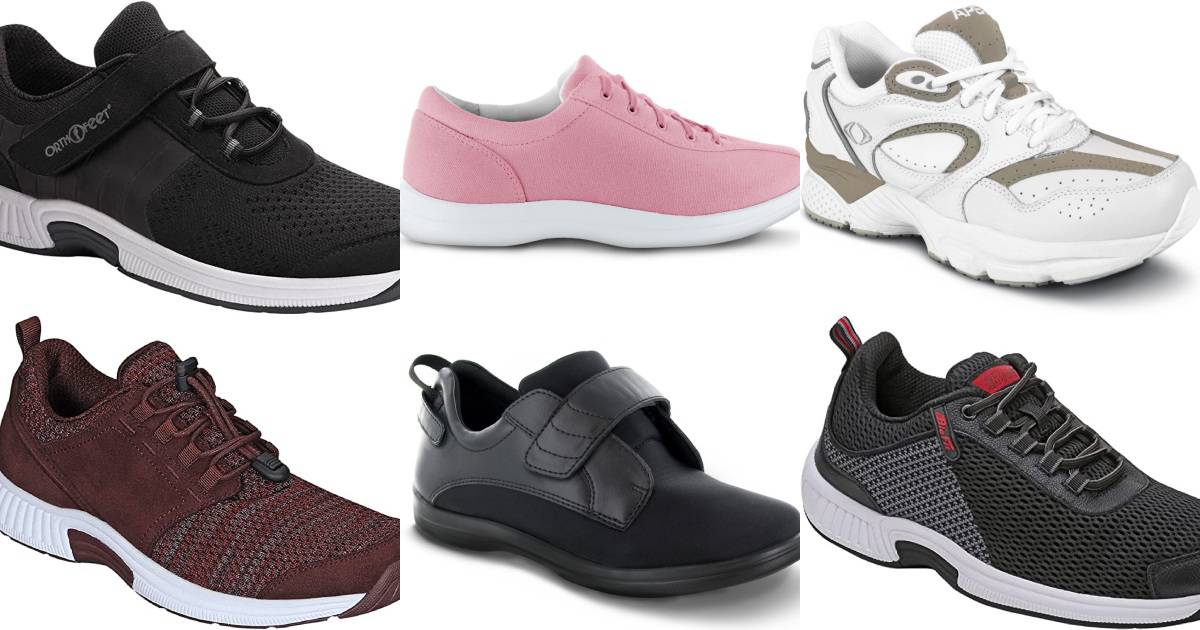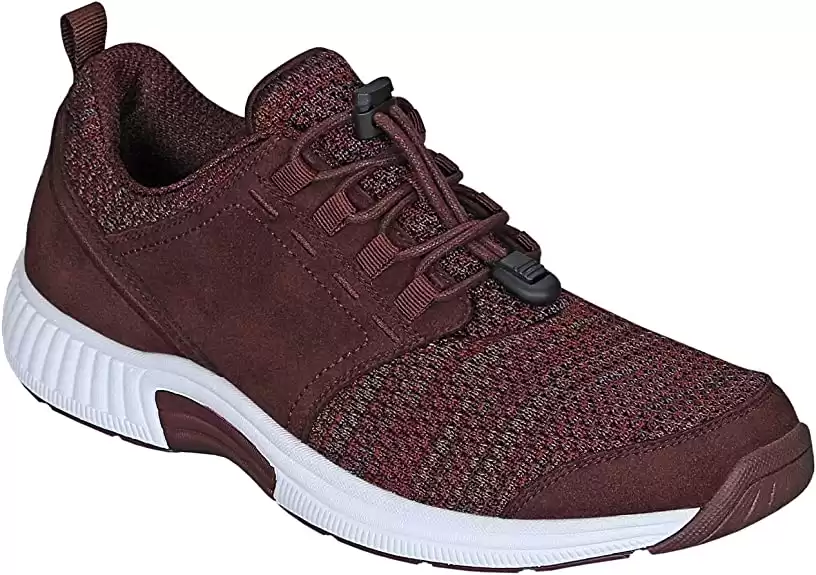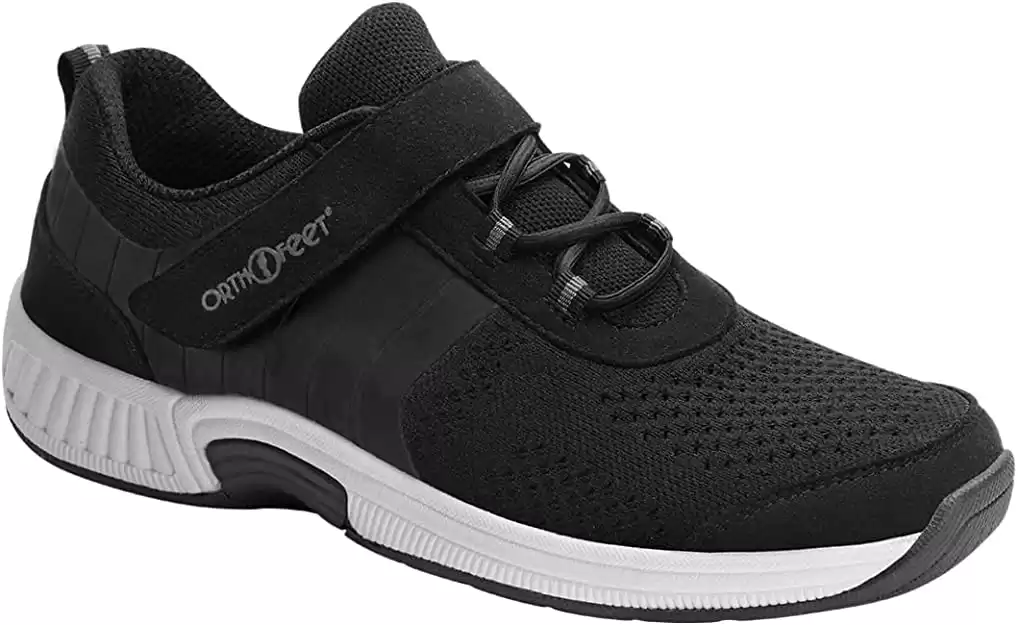This post may contain affiliate links. Please read our disclosure.
If you are experiencing diabetes-related neuropathy, we’ve listed some of the best shoes for your condition below.
You’ll also learn from our buying guide what features you should look for in diabetic shoes, including the types of shoes that you should avoid.

Why do you need special shoes if you have neuropathy?
Diabetes can lead to nerve damage that leads to a loss of feeling all over the body, known as neuropathy.
Many people living with diabetes experience this in the feet, making calluses, sores, and injuries more likely to occur.
Neuropathy can mean that these injuries go unnoticed, but as diabetes makes them take a longer time to heal, they can become infected, requiring serious treatment later.
Wearing shoes designed for neuropathy may help you avoid injuries and infections, manage pain, and maintain good balance.
Diabetic neuropathy shoe review
It’s important to find a neuropathy shoe with the right combination of cushioning and support, room for the toes, and breathable anti-microbial fabric.
Here are our top picks for men and women
The best men’s shoes for diabetic neuropathy
These Orthofeet shoes are built with Orthotic insoles, designed to support and cushion the feet while walking.
They have several features that can keep the feet safe and secure, including cushioned foam layers, arch support, and heel padding.
The sneakers also have extra depth and a roomy toe box, giving the feet space to move freely.
The stretchy uppers conform to the feet to prevent any friction injuries, while the anti-odor foam and fabric insole prevent bacteria buildup to keep the feet healthy.
- Removable insoles: Can be removed to substitute for preferred insoles
- Anti-odor foam and fabric: Prevent bacteria buildup to keep the feet healthy and dry
- Cushioning foam insole: Adds support while relieving pressure, keeping the feet comfortable
- Available in several width options: Suitable for a range of sizes and those that need more room in their shoes
- Outsole may not have enough traction in wet or rainy conditions
This walking shoe from Apex is designed to relieve pressure and pain felt in the feet, helping you feel more comfortable while you walk.
They have a firm heel collar that keeps the feet stable during movement, which is ideal for anyone experiencing balance-related neuropathy symptoms.
The upper materials are made from leather and open-air mesh, a breathable material that keeps the feet dry and healthy.
A notable feature is the shoe's two removable layers, which lets you customize the shoe’s depth to your liking.
This is a good feature for feet that swell up after walking during the day, giving them more space to move if required.
The walking shoes also have a durable rubber outsole that supports the feet and prevents any impact from affecting the feet.
- Extra-depth: More room for the toes and feet so they remain comfortable
- Shock absorbing outsole: Absorbs impact from walking so the feet don’t feel additional pain
- Antimicrobial mesh lining: Breathable and prevents bacteria growth, keeping diabetic feet healthy
- Mix of leather and mesh materials can be harder to clean.
The Apex Balance Shoe is designed specifically to reduce fall risk – the first of its kind on the market.
It has a low-profile heel for maximum postural stability and a slip-resistant sole.
The textured insole provides sensory feedback to people with neuropathy and limited feeling in the feet.
Both the heel and top of the shoe has a convenient loop closure that makes putting the shoe on and adjusting it very easy.
- Reduces the risk of falls: Every part of the shoe was designed with this goal in mind
- Easy to get on and off: Loop closure system in both heel and top
- Textured insole: Gives sensory feedback
- Less space in the toe box than some other neuropathy shoes
These slip-on sneakers from Skechers are built with a lot of cushioning features ideal for anyone with neuropathy-related foot pain.
The midsole is made with the brand’s Ultra Go technology that gives your feet an extra spring in your step when on the move.
The cushioned midsole is also layered with additional padding from the Goga Mat insole, which shapes to your foot for a customized fit.
The uppers are made from a soft canvas that is breathable and lightweight so the sneakers are well-ventilated, keeping the feet healthy and dry from the air flowing through them.
The outsole uses Skechers Ultra pillars, which are rubber pods that support your feet with each step, cushioning your feet from any impact felt from walking.
The rubber is also a durable material that will last a long time, along with the extra canvas overlays in the uppers that defend against wear and tear.
The slip-on design is attractive and lets you remove the shoes easily, but this may not be the most supportive design for anyone with balance issues from neuropathy.
- Durable rubber outsole: Strong material that protects against impact
- Slip-on design: Easy to wear and remove the shoes
- Soft canvas upper: Breathable and comfortable material that keeps feet healthy and dry
- Slip-on design may not offer as much support as lace-up or hook-and-loop closure styles.
The best women’s shoes for diabetic neuropathy
Orthofeet also leads the way when it comes to comfortable women’s shoes.
The Francis No-Tie Shoe is equipped with many characteristics that can relieve neuropathy pain.
They come with removable orthotic insoles with anatomical arch support to re-align the foot and entire body posture.
The toe box is wide and the soft, padded fabric interior with no overlays eliminates irritation and provides great protection.
Available in 3 width sizes and 5 color finishes, these are a great option for women that are experiencing foot sensitivity symptoms.
- Premium orthotic insoles: Great support for your feet
- Wide toe-box: Alleviates pressure on swollen feet
- Bungee lace closure: Easy to take on/off
- Bungee closure design may not be as supportive as lace-up options
This is a super lightweight and stylish neuropathy shoe for daily use.
It's made from moisture-wicking polyester with antimicrobial mesh lining and full-grain leather and canvas uppers.
It comes with 5/16” in removable depth for fitting flexibility and the ability to use orthotic inserts.
You can choose between pink, navy blue, and white.
This is one of the best options if you want a neuropathy shoe that looks like a "normal" shoe.
- Soft and lightweight: Perfect for everyday use
- Great looking: Stylish and doesn't look like a neuropathy shoe
- Doesn't have removable insoles
- Not suitable for people with advanced neuropathy
The Joelle model is one of the most lightweight neuropathy shoes from Orthofeet.
It has all the advanced neuropathy support features of heavier shoes (removable orthotic insoles, a wide toe-box, moisture-wicking fabric, etc.) but in a more sporty sneaker.
It has a combination of a hook & loop strap with an elastic cord that makes it very easy to get on and off.
- Lightweight: Same technology as heavier shoes but in a light sneaker
- Sporty: Great for an active lifestyle
- Not great for rain and snow
These women’s walking shoes are a great choice for those that often experience swollen feet, as well as anyone that needs extra width in their shoes.
Propet has made its footwear available in four different width sizes, so you can be sure that your feet won’t feel constricted throughout the day.
These shoes are fitted with dual-layer insoles. These support the feet well and can be removed to give the feet more breathing room or to add your orthotic insoles.
The upper leather materials adjust to the contours of your feet, ideal for diabetes patients that are prone to sores, corns, or bunions.
The slip-on design makes it easy to put the shoes on, while the adjustable straps help the wearer feel safe, supported, and secure while moving.
- Stretchy leather upper: Adapts to the shape of the feet to prevent friction injuries
- Removable dual layer insoles: Can be removed to add more depth or add an orthotic insole
- Slip-on design with adjustable straps: Makes the shoes easy to wear while adding extra support
- Four width sizes: Suitable for a range of sizes and prevents feet from feeling constricted
- Very distinct visual design that isn't for everybody
If none of the shoes above are perfect for your needs, I highly recommend browsing the Orthofeet neuropathy shoe store for more options. They have the largest selection of neuropathy shoes.
Diabetic neuropathy shoe buying guide
Wearing the right shoes is critical if you live with diabetic neuropathy. Here is what you need to be aware of when buying your next pair of shoes.
Find the right size shoe
The University of Dundee conducted a study and found that six out of ten people living with diabetes wear the wrong size shoes.
Your shoes need to fit properly and match the shape of your feet. Shoes that are too tight or too loose can lead to the feet sliding in the shoes.
The added friction can cause calluses, blisters, and sores, which are dangerous for anyone living with diabetes.
Neuropathy can also make pain from a tighter-fitting shoe go unnoticed. Cuts and injuries can develop on the feet as a consequence, which may become infected later.
If you haven’t had your feet measured recently, go to a shoe store to see what size shoe is best for you.
Features to look out for in diabetic shoes
After you have found out what your correct shoe size is, here are the things you should look for when shopping for diabetic shoes:
Cushioning and support
Anyone that lives with diabetes needs to wear footwear that supports and cushions their feet well. Most suitable shoes are built with arch and heel support, including cushioning around the balls of the feet.
They are also made with softer fabric around the tops of the shoes to prevent the skin from experiencing cuts or irritation.
It’s best to avoid very elastic shoes, as these will be made from softer materials that can be easily punctured by sharp objects, injuring your feet.
Similarly, you shouldn’t opt for shoes that are too rigid or stiff, as these won’t be comfortable to wear. These will be made from harder materials that can rub against the skin, leading to sores and blisters.
Look for footwear that has lots of room in the toe box and make sure that they don’t bend easily around the arch. Try to find options with removable soles so you can replace them with orthopedic inserts later.
Toe box depth
Extra-depth refers to the toe box of the shoes. Extra room in this area can defend the feet from harm when the foot experiences extra pressure or swells up during the day.
Diabetic shoes shouldn’t be restricting, but they should give the feet enough breathing space.
Look out for extra-depth shoes, as these are around half an inch deeper to adapt to foot changes. The extra room also provides space for orthotic inserts, if you use them.
Closed toe full coverage
Updates in footwear have led to several diabetes-suitable sandal designs, but it’s still advised for diabetes patients to stick to closed-toe options.
These will better protect the feet from injuries and damage. Just the smallest cut can lead to serious infections in anyone living with diabetes, so it’s important to reduce the risk of this happening whenever possible.
These shoes should cover the feet well, but they shouldn’t be constricting or fit too tightly. This can lead to rubbing inside the shoe, causing calluses and sores later.
Neuropathy symptoms that reduce sensations in the feet can make these go unnoticed, leading to the sores becoming infected soon after.
Orthopedic shoes
Orthopedic footwear is designed for people with foot problems, like corns, bunions, or hammertoes.
You don’t need to have diabetes to wear orthopedic shoes, but they may be able to help with a lot of foot issues related to the condition.
Orthopedic shoes have several features that are designed for comfort, including:
- A strong outsole and midsole
- Strong heel counter
- Several widths measurements to fit a variety of foot sizes
- Removable liner to fit custom orthotics
You can also purchase orthotics, which are shoe inserts designed to deliver comfort and relieve pressure on the feet.
Types of shoes to avoid
Here are some examples of shoes that anyone living with diabetes should avoid:
- Shoes with pointed toes, as these will affect circulation, irritating the toes in the process.
- Shoes without sufficient arch support, as they can cause tissue deterioration within your feet.
- Shoes that fit poorly, as these can lead to foot injuries.
- High heels, as these can cause foot issues and injuries. It’s best to stick to heels two inches high or under.
Don’t wear open-toe shoe designs, like sandals or flip-flops. Straps can add extra pressure on your feet, causing blisters and calluses.
Open-toe shoes can increase the risk of cuts and injuries, as small stones and debris can enter the shoes.
It’s a good idea to purchase, at least, two pairs of shoes designed for people with diabetes. Changing the shoes you wear each day will give each pair a chance to air out and dry when you are not wearing them.
A lot of people purchase uncomfortable shoes, planning to break them in later. This is never recommended, especially if you live with diabetes.
Your shoes should be comfortable when you try them on for the first time.
If you take off a new pair after wearing them for a while and find that you have red, sore areas on your feet, don’t wear the shoes again.
Don’t go barefoot
After you have found footwear that fits correctly and are comfortable, make sure you wear them most of the time. Never go barefoot, even around your home.
A lot of people with neuropathy symptoms can walk on small objects without even knowing it.
There’s always a small risk of stepping on a sharp item, not feeling the pain, and injuring your feet.
Diabetes makes foot injuries very dangerous, so it’s always best to put on slippers or shoes in your house, even if you need a quick trip to the bathroom at night.
Frequently Asked Questions
Do diabetic shoes help with neuropathy?
Diabetic shoes can be designed with impressive features that can help relieve neuropathy symptoms.
One important feature is stretchable uppers which is an ideal feature for those experiencing severe neuropathy symptoms. These uppers contour to the shape of the foot, relieving any pressure on certain points.
Other examples include a deeper toe box that eases pressure on the toes, orthotic insoles that cushion the feet, and a softer lining that won’t irritate or rub against the feet.
Will my insurance cover neuropathy shoes?
That depends on your insurance and the exact nature of your condition. Ask your insurance provider if they cover neuropathy shoes before you buy.
If you have Medicare, you may be covered if you have diabetes and a prescription for therapeutic shoes from a podiatrist.
What helps diabetic neuropathy in your feet?
Controlling your blood sugar is the best way to prevent any further nerve damage. This involves healthy lifestyle choices, like eating a nutritious diet and getting in enough physical activity.
Pain-relieving medications may help with nerve pain, while others see improvement from alternative therapies, like capsaicin cream and acupuncture.
Always consult your doctor before trying these, as they may not be compatible with your treatment plan.
Can you reverse diabetic neuropathy in the feet?
At present, there is no way to reverse diabetic neuropathy, though researchers and scientists are trying to find solutions all the time.
While diabetic neuropathy cannot be reversed, it can be managed by controlling your blood sugar through lifestyle and medication.
Some options can treat neuropathy symptoms. These might include painkillers for sensory symptoms, medications to target vomiting and nausea, or prescription medications to treat erectile dysfunction.
Other products that help diabetic neuropathy
After you buy the right diabetic neuropathy shoes, you should still consider other products that can help prevent or manage neuropathy. Here are some of the products we have reviewed:











